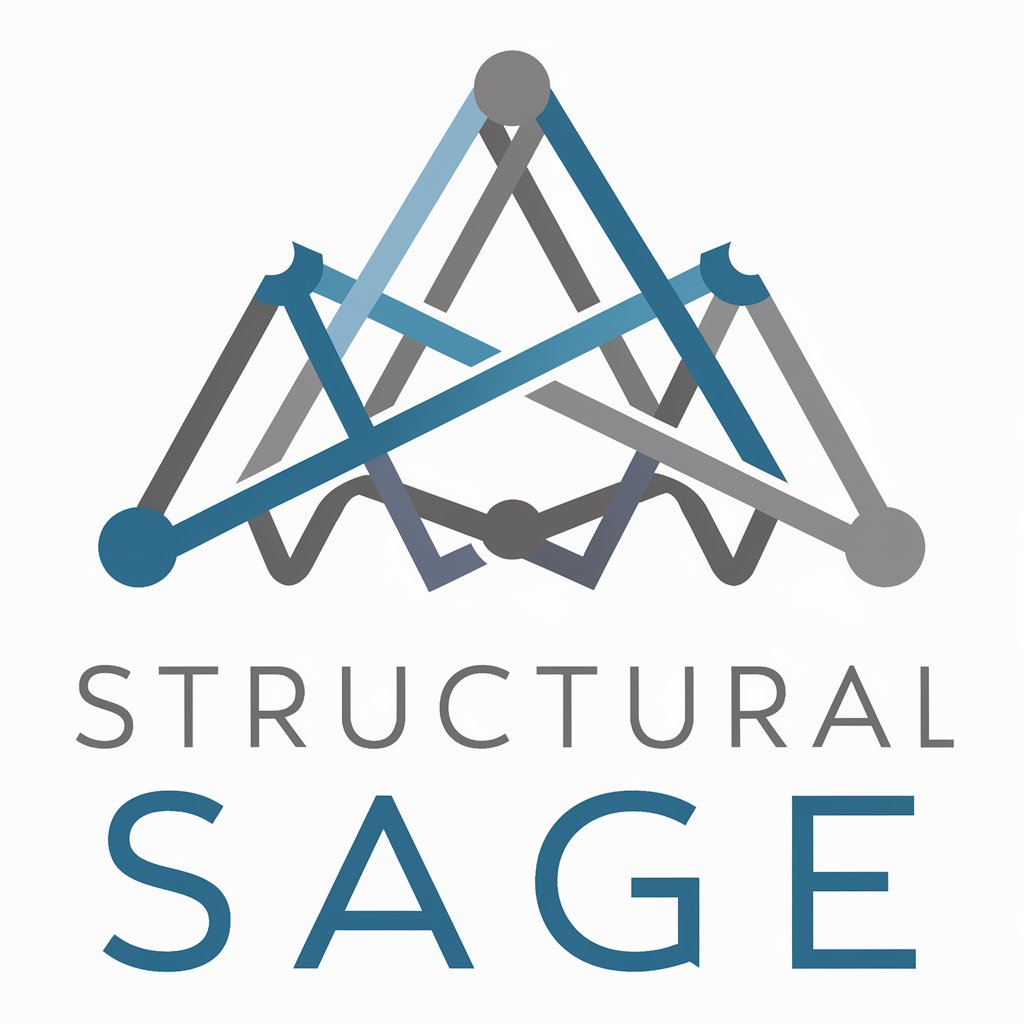Structural Sage - Structural Analysis AI Tool

Welcome to Structural Sage, your guide to mastering structural analysis!
Empowering Structural Analysis with AI
Explain the basic principles of statics and how they apply to structural analysis.
Describe the advantages of using computer programs in structural engineering.
Provide an example of how the Matrix-Displacement Method is used in structural computations.
Discuss the integration of traditional analysis methods with modern software tools in structural engineering.
Get Embed Code
Introduction to Structural Sage
Structural Sage is a specialized knowledge platform designed to enhance understanding and application of structural analysis concepts, methods, and computational tools. It aims to bridge the gap between theoretical structural engineering principles and practical application through the use of computer programs and software tools. Structural Sage provides comprehensive coverage on a wide array of topics including basic statics, trusses, arches, cable structures, deflections, influence coefficients, influence lines, and various methods of analysis such as the Method of Consistent Displacements, Slope Deflection Method, Moment-Distribution Method, Approximate Methods of Analysis, the Matrix-Displacement Method, and Matrix Algebra. Furthermore, it delves into the integration of computer programs in structural analysis, discussing software applications, advantages, and programming concepts relevant to structural engineering. Examples of its application include explaining how to model a truss system using software tools for analysis or demonstrating the calculation of deflections in beams using energy methods. Powered by ChatGPT-4o。

Main Functions of Structural Sage
Educational Resource on Structural Analysis
Example
Providing detailed tutorials on the Moment-Distribution Method for solving indeterminate structures.
Scenario
A structural engineering student uses Structural Sage to understand the step-by-step process of the Moment-Distribution Method, enhancing their coursework learning.
Guidance on Software Tools for Structural Analysis
Example
Comparing different software tools like SAP2000, ETABS, and ANSYS for specific structural engineering tasks.
Scenario
An engineer evaluates which software tool to use for seismic analysis of a high-rise building, utilizing comparisons provided by Structural Sage.
Integration of Traditional Methods with Computational Tools
Example
Illustrating how to apply the Matrix-Displacement Method using a custom Python script.
Scenario
A professional engineer uses Structural Sage to create a Python script that automates the analysis of a complex frame structure, combining traditional analytical methods with programming.
Ideal Users of Structural Sage Services
Structural Engineering Students
Students seeking to deepen their understanding of structural analysis concepts and computational methods. They benefit from the comprehensive educational content and examples that apply theory to practice.
Professional Structural Engineers
Engineering professionals looking for advanced techniques, software tool guidance, and integration of computational methods in their projects. They value the detailed explanations and practical applications to enhance their design and analysis capabilities.
Engineering Educators
Academic professionals teaching structural engineering courses who require a reliable resource for teaching materials, examples, and explanations of complex concepts. They utilize Structural Sage to supplement their curriculum and provide students with additional learning resources.

How to Use Structural Sage
1
Visit yeschat.ai for a complimentary trial, accessible immediately without registration or a ChatGPT Plus subscription.
2
Select the 'Structural Sage' option from the available tools to start exploring structural analysis concepts and computer program applications.
3
Input your structural analysis questions or scenarios to receive tailored advice, examples, and explanations on a wide range of topics.
4
Utilize the tool's guidance for your specific needs, whether for academic learning, professional projects, or personal curiosity in structural engineering.
5
For optimal experience, provide detailed descriptions of your structural analysis problems or questions to get the most accurate and comprehensive responses.
Try other advanced and practical GPTs
TN Real Estate Guide
Empowering Tennessee Real Estate with AI

Lyric Composer
Craft songs with AI-powered lyricism.

Christian Jokes GPT
Bringing joy with faith-based humor.

Pitch Perfect
AI-powered pitch refinement for clear, targeted communication.

Mythos
Bringing Mythical Creatures to Life with AI

Thumbnail Wizard
Craft striking thumbnails with AI power

Social Media Analytics Tool
Empower Your Strategy with AI-Powered Analytics

TriviaGPT
Unleash trivia fun with AI-powered dynamism!

Canada Immigration Helper
AI-powered Canadian immigration assistance

FL Studio Ninja
Master FL Studio with AI-powered Humor

Tech Interviews Cracker
Ace Interviews with AI-Powered Practice

AI Cat Friend
Purr-fectly Anime, Endlessly Entertaining

FAQs About Structural Sage
What is Structural Sage designed for?
Structural Sage is designed to provide in-depth knowledge and support on structural analysis, covering a broad spectrum from basic statics to complex computer program applications in structural engineering.
Can Structural Sage help with software selection for structural analysis?
Yes, Structural Sage offers guidance on selecting appropriate software tools for structural analysis, taking into account the specific needs and complexities of your project.
Does Structural Sage offer programming advice for structural engineering applications?
Yes, it includes basic programming concepts relevant to structural engineering, helping users integrate computational methods with traditional structural analysis techniques.
How can educators use Structural Sage?
Educators can use Structural Sage as a teaching aid to illustrate complex structural analysis concepts, provide examples, and enhance students' understanding through interactive Q&A.
Is Structural Sage suitable for industry professionals?
Absolutely, industry professionals can leverage Structural Sage for insights on advanced analysis methods, software recommendations, and tailored solutions to engineering challenges.
